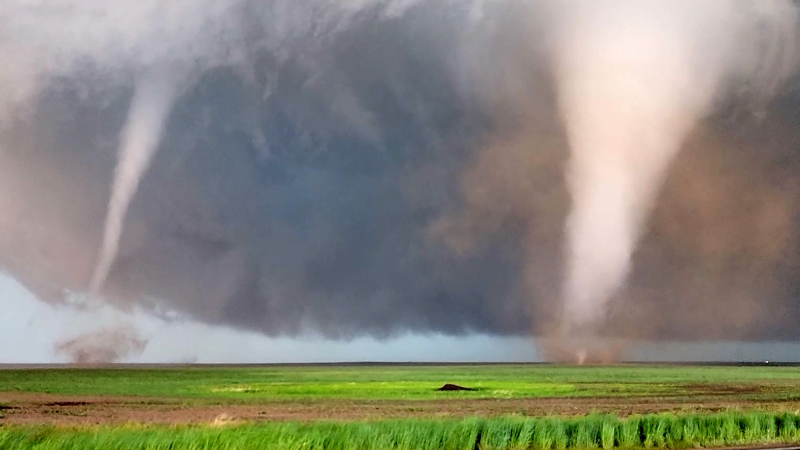Tracking tropical trouble in the Atlantic for late October
There is over a month left in the Atlantic hurricane season, and forecasters are highlighting the Caribbean as the area to watch for the next tropical storm that could threaten lives and property.
In today’s Forecast Feed, AccuWeather’s Bernie Rayno breaks down the latest on the tropics.
AccuWeather meteorologists are tracking what may become the next threat to lives and property in the Caribbean, Central America and potentially the United States before the end of October in the closing stages of the Atlantic hurricane season.
Former Tropical Storm Lorenzo has lost all tropical characteristics and is no longer being tracked in the open Atlantic.

This wide view mosaic image of the tropical Atlantic was captured on Thursday, Oct. 16, 2025. The tropical wave being tracked was in the lower left of the center of the image. (AccuWeather Enhanced RealVue™ Satellite)
"The feature that we are keeping a close eye on is a large, but thus far poorly organized, tropical wave of low pressure that moved off the coast of Africa earlier this week," AccuWeather Lead Hurricane Expert Alex DaSilva said. "This may be among the final tropical waves of the season."
Tropical waves are poorly organized areas of showers and thunderstorms that form over the Indian Ocean or Africa and drift westward across the Atlantic. Under the right conditions, one in three to five of these evolves into named tropical storms.
"Tropical storms can develop from other means, especially near the beginning and tail end of the season, so the risk of development will extend well beyond one of the final tropical waves of the season," DaSilva said.
"This is the tropical wave that could go on to define the Atlantic tropical season in terms of impact, should it get past hurdles in the coming days," AccuWeather Chief On-Air Meteorologist Bernie Rayno said during a recent interview.
The tropical wave has a long way to go before entering the open waters of the Caribbean. It is expected to remain poorly organized until it crosses the eastern islands that mark the beginning of the Caribbean Sea late this weekend.
GET THE FREE ACCUWEATHER APP
•Have the app? Unlock AccuWeather Alerts™ with Premium+
"Should the system get past issues with dry air, combative winds (wind shear) and proximity to the equator, it could intensify quickly once it reaches the warm and virtually untouched waters of the Caribbean next week," DaSilva added to Rayno's comment in the interview.
Proximity to the northern coast of South America could pose a challenge to development as the system enters the Caribbean. But if the storm is able to distance itself from the land mass, wind shear is forecast to be low. High pressure over the top of the storm could allow for rapid strengthening.

There are multiple scenarios where the wave could travel after reaching the Caribbean.
One scenario is that the wave waits to develop until it approaches Central America. Depending on steering breezes at the time, it may continue westward across Central America or turn northward toward Florida.
In a worst-case scenario, the wave could organize into a tropical storm over the central Caribbean and move northward with a track near the U.S. Atlantic coast. Non-tropical weather systems could then draw the storm onshore with heavy rain, coastal flooding and high winds during the last week of the month.

Hurricane Sandy (2012) formed in a similar part of the Caribbean and followed a comparable track to this scenario across Cuba and the Bahamas before making a left turn as a non-tropical storm grabbed on.
AccuWeather meteorologists emphasize that while this is not the most likely scenario at this time, there is a wide range of development and track possibilities. However, based on the anticipated weather pattern and historical records, the Caribbean could be the spot for the next tropical storm and hurricane to form and affect populated areas from next week to the end of the month.

The next two names on the list of tropical storms for the 2025 Atlantic hurricane season are Melissa and Nestor. There is a non-tropical system over the northwestern Atlantic that may develop into a tropical or subtropical storm over the next several days, which would be well ahead of the tropical wave near the equator.
The Atlantic hurricane season does not officially end until Nov. 30. As the peak period for tropical waves concludes in late October and November, tropical development tends to occur close to Central America, the north-central Atlantic and in waters surrounding the southeastern U.S. coast.
As of Oct. 17, there have been four hurricanes, of which three became major hurricanes with peak sustained winds of 111 mph or greater. There have been 12 named tropical storms and one unnamed tropical wind and rainstorm that affected the U.S. East Coast from Oct. 10-14.
"There may be as many as three more tropical storms and perhaps two more hurricanes for the rest of the season," DaSilva said.

"There is a significant chance that the additional hurricanes would become a Category 3 major hurricane or greater," DaSilva added.
Want next-level safety, ad-free? Unlock advanced, hyperlocal severe weather alerts when you subscribe to Premium+ on the AccuWeather app. AccuWeather Alerts™ are prompted by our expert meteorologists who monitor and analyze dangerous weather risks 24/7 to keep you and your family safer.
Report a Typo














